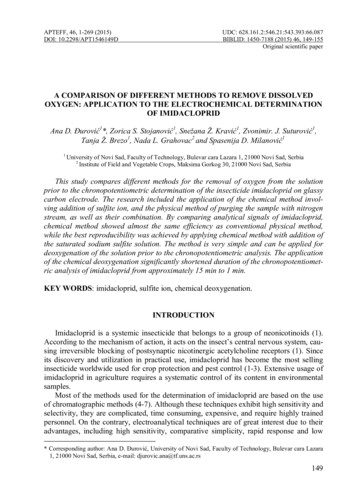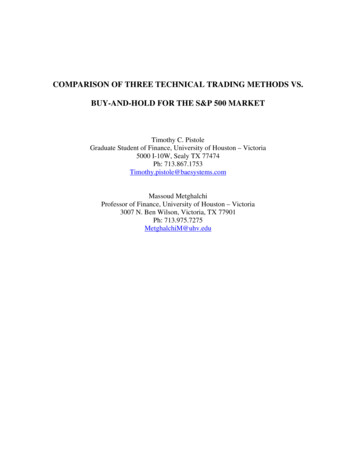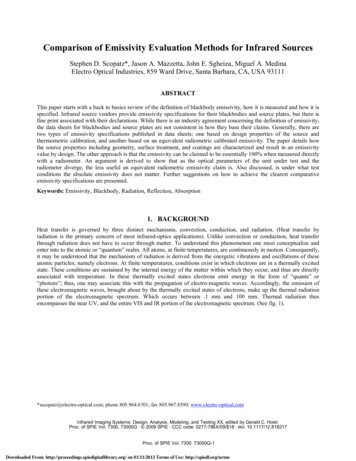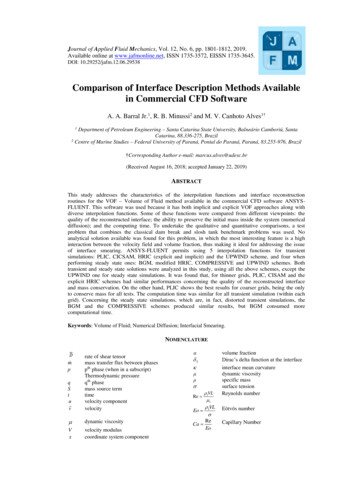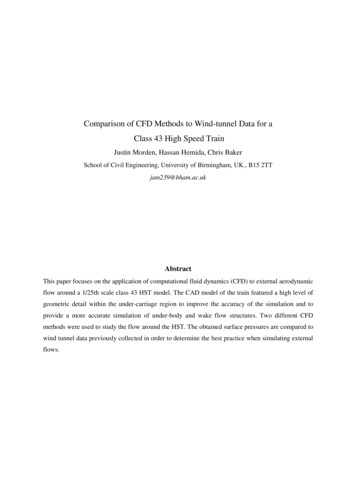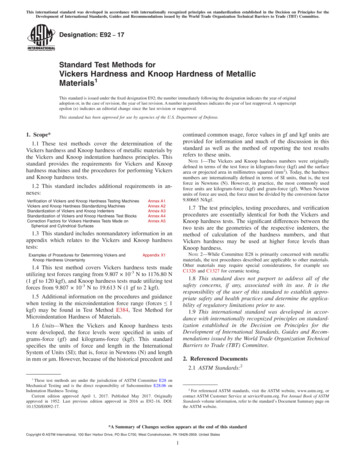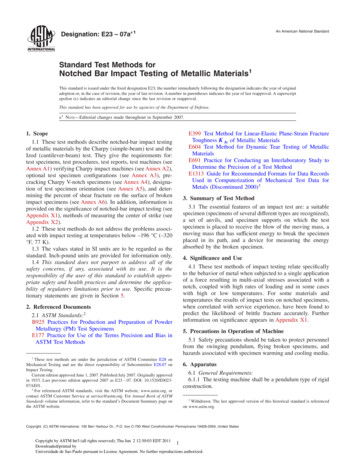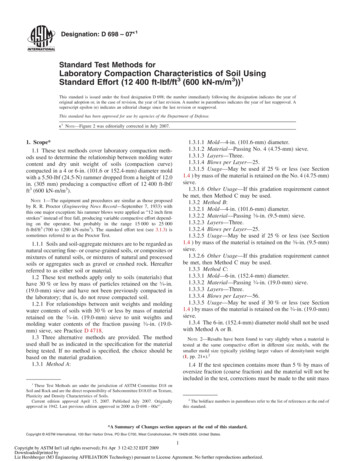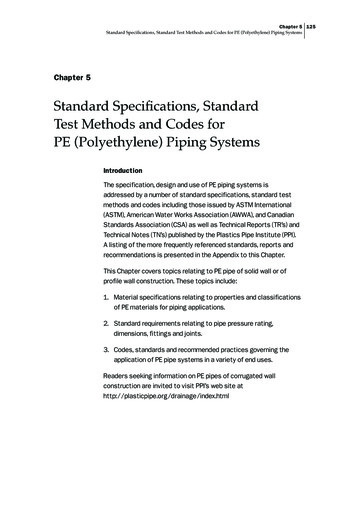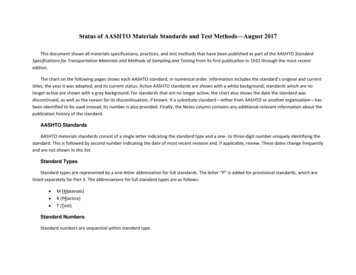
Transcription
COMPARISON OF TEST METHODS ON THECOMPRESSIVE STRENGTH OF FLY ASH BLENDED CEMENTSA THESIS SUBMITTED TOTHE GRADUATE SCHOOL OF NATURAL AND APPLIED SCIENCESOFMIDDLE EAST TECHNICAL UNIVERSITYBYHASAN TUNÇIN PARTIAL FULFILLMENT OF THE REQUIREMENTSFORTHE DEGREE OF MASTER OF SCIENCEINCIVIL ENGINEERINGJUNE 2014
Approval of the thesis:COMPARISON OF TEST METHODS ON THECOMPRESSIVE STRENGTH OF FLY ASH BLENDED CEMENTSsubmitted by HASAN TUNÇ in partial fulfillment of the requirements for the degreeof Master of Science in Civil Engineering Department, Middle East TechnicalUniversity by,Prof. Dr. Canan ÖzgenDean, Graduate School of Natural and Applied SciencesProf. Dr. Ahmet Cevdet YalçınerHead of Department, Civil EngineeringProf. Dr. İsmail Özgür YamanSupervisor, Civil Engineering Dept., METUProf. Dr. Mustafa TokyayCo-Supervisor, Civil Engineering Dept., METUExamining Committee Members:Assoc. Prof. Dr. Sinan Turhan ErdoğanCivil Engineering Dept., METUProf. Dr. İsmail Özgür YamanSupervisor, Civil Engineering Dept., METUProf. Dr. Mustafa TokyayCo-Supervisor, Civil Engineering Dept., METUAsst. Prof. Dr. Çağla MeralCivil Engineering Dept., METUAssoc. Prof. Dr. Mustafa ŞahmaranCivil Engineering Dept., Gazi UniversityDate:, 201019.06.2014
I hereby declare that all information in this document has been obtained andpresented in accordance with academic rules and ethical conduct. I also declarethat, as required by these rules and conduct, I have fully cited and referencedall material and results that are not original to this work.Name, Last name: Hasan TunçSignature:iv
ABSTRACTCOMPARISON OF TEST METHODS ON THECOMPRESSIVE STRENGTH OF FLY ASH BLENDED CEMENTSTunç, HasanM.Sc., Department of Civil EngineeringSupervisor: Prof. Dr. İsmail ÖzgürYamanCo-Supervisor: Prof. Dr. Mustafa TokyayJune 2014, 54 pagesIn Turkey the compressive strength of cements are determined according to TS EN196-1. That standard suggests the use of a constant water-cement ratio of 0.50 inpreparation of mortar specimens for all types of cements. On the other hand, in USAcement producers use ASTM C 109 to determine the compressive strength ofcements, which is based on a constant consistency of cement mortars for blendedcements only. The main difference of these methods is the needed amount of water toproduce cement mortar.When a constant w/c is used to prepare mortar specimens as specified by TS EN 1961, especially for certain blended cements insufficient compaction may occur andcompressive strength may not be obtained in a standard repeatable manner. On theother hand, when ASTM C 109 is used, higher amount of water may be used toobtain a constant consistency and the compressive strength can be lower. Therefore,in this study, unlike EN 196-1 and ASTM C 109, a constant water/cementitious byvolume method is suggested to prepare mortar specimens to determine their strength.v
The aim of this thesis is to demonstrate the variabilities that can be confronted withthe determination of compressive strength of fly ash blended cements. For thispurpose, portlant cement clinker was replaced with fly ash (FA) at 20 %, 35 %, 55% replacement levels, by using three different methods which are acquired by theconstant water/cementitious by mass (EN 196-1), constant flow (ASTM) andconstant water/cementitious by volume methods,7-day and 28-day compressivestrength of mortars were obtained. Then, coefficient of variation (CoV) of the resultsobtained by three different methods were compared.After the experimental study, it was observed that a less deviation in the compressivestrength results were obtained by constant water/cementitious by volume method andASTM C109 method. However, for the constant water/cementitious by mass method(EN 196-1), higher deviance in the compressive strength results were obtained. As aresult, it was determined that the constant water/cementitious by mass method (EN196-1) is not proper for fly ash blended cements.Keywords: Fly Ash, Compressive Strength, Coefficient of Variation, Mortarvi
ÖZTEST YÖNTEMLERİNİN UÇUCU KÜLLÜ ÇİMENTOLARINBASINÇ DAYANIMLARI ÜZERİNDEN KARŞILAŞTIRILMASITunç, HasanYüksek Lisans, İnşaat Mühendisliği BölümüTez Yöneticisi: Prof. Dr. İsmail Özgür YamanOrtak Tez Yöneticisi: Prof. Dr. Mustafa TokyayHaziran 2014, 54 sayfaTürkiye’de basınç dayanımları TS EN 196-1 göre belirlenmektedir. Bu standardbütün çimento tiplerinin hazırlanması için sabit 0,50 su-çimento oranınıönermektedir. Diğer taraftan Amerika çimento üreticileri basınç dayanımlarınınbelirlenmesi için sabit kıvam değerini esas alan ASTM C 109 kullanmaktadır. Bumethodlar arasındaki ana fark harçların hazırlanmasında gerekli olan su miktarıdır.Katkılı çimento harcı üretmek için TS EN 196-1 kullanıldığı zaman yetersizsıkıştırma problemleri oluşabilir ve basınç dayanımları standardta istenilen şekildeelde edilemeyebilir. Diğer taraftan ASTM C 109 yöntemi kullanıldığında sabit birkıvam elde etmek için yüksek su miktarı kullanılabilir ve bu durum basınçdayanımının azalmasına neden olabilir. Belirtilen sebeplerden dolayı, bu tezde TSEN 196-1 ve ASTM C 109 yöntemlerinden farklı olarak dayanım numunelerininhazırlanması için hacimsel sabit su-çimento oranı önerilmektedir.Bu tezin amacı uçucu küllü katkılı çimentoların basınç dayanımlarının ölçümündekarşılaşılabilen değişkenlikleri göstermektir. Bu amaç için uçucu kül içeren katkılıçimentolar kullanılmıştır. % 20, % 35, % 55 uçucu kül içeren katkılı çimentolarvii
hazırlanarak kütlece sabit su/bağlayıcı oranı (TS EN 196-1), sabit yayılma değeri(ASTM) ve hacimce sabit su/bağlayıcı oranı olarak 3 farklı yönteme göre 7 ve 28günlük basınç dayanımları elde edilmiştir. Daha sonra, üç yöntemden elde edilenbasınç dayanım sonuçlarının varyasyon katsayıları karşılaştırılmıştır.Deneysel çalışmalar sonrasında, hacimsel sabit su-çimento oranı ve ASTM C 109yöntemiyle elde edilen harçların basınç dayanım sonuçlarındaki sapmalar daha düşükolarak gözlemlenmiştir. EN 196-1 yöntemleriyle elde edilen harçların basınçdayanım sonuçlarındaki sapmalar daha fazladır. Sonuç olarak katkılı çimentolar içinkütlece sabit su/bağlayıcı oranı yönteminin (TS EN 196-1) kullanılmasının uygunolmadığı sonucuna varılmıştır.Anahtar Sözcükler: Uçucu Kül, Çimento Basınç Dayanımı, Varyasyon Katsayısı,Harçviii
To My Familyix
ACKNOWLEDGMENTSI would like to express my sincere gratitude to my supervisor Prof. Dr. İsmail ÖzgürYaman and my co-supervisor Prof. Dr. Mustafa Tokyay for their guidance andsuggestions and support throughout this research.I appreciate the help provided by Abdullah Usame TOKGÖZ especially for hisassistance and comments.Sincere thanks are extended to TSE for allowing laboratory facilities to use andTCMA for supplying all the cements that I used throughout my thesis study.I also would like to thank to my colleague and my friend Erhan TETIK in TSE forhis enthusiastic support during the thesis.Finally; I am grateful to my parents, especially my mother, for their patience,encouragement and support.x
TABLE OF CONTENTSABSTRACT . vÖZ . viiACKNOWLEDGMENTS . xTABLE OF CONTENTS . xiLIST OF TABLES . xiiiLIST OF FIGURES . xivLIST OF ABBREVIATIONS . xviCHAPTERS . 11.INTRODUCTION . 11.1. General . 11.2. Objective and Scope of the Thesis . 32.THEORETICAL CONSIDERATIONS . 52.1. Production of Portland Cement . 52.2 Main Constituents of Cement . 62.2.1 Fly Ash (FA) . 72.2.1.1 Class F Fly Ash . 92.2.1.2 Class C Fly Ash . 102.2.1.3 Fly Ash Chemistry . 102.2.1.4 Effects of FA on Concrete Properties . 113.EXPERIMENTAL STUDY . 153.1 General . 153.2 Materials . 153.3 Mixture Preparation of Mortars . 193.4 Compressive Strength Test Procedure . 22xi
3.5 Comparison of Test Methods . 234.RESULTS AND DISCUSSIONS . 254.1 General. 254.2 Compressive Strength Test Results . 254.2.1 20% Fly Ash-Blended Cement (FA20). 254.2.2 35% Fly Ash-Blended Cement (FA35). 334.2.3 55% Fly Ash-Blended Cement (FA55). 404.3 Comparison of the Compressive Strength Test Results for FA20, FA35 and FA55 Blended-Cements. 474.4 Comparison of Coefficient of Variance for Different Test Methods . 485.SUMMARY AND CONCLUSIONS. 515.1 General. 515.2 Recommendations for Further Studies . 52REFERENCES . 53xii
LIST OF TABLESTABLESTable 1 Percentage of Cement Composition. 7Table 2 Typical Chemical Composition of Fly Ash . 9Table 3 Chemical Composition of the Materials . 16Table 4 Proportions of Ingredients . 16Table 5 Ingredients Used In Mixture of the Cement Mortars . 19Table 6 Specific Gravity of Ingredients . 21Table 7 Water Content for C-Volume Method . 22Table 8 Comparison of ASTM C 109 & EN 196-1 . 23Table 9 Compressive Strength Test Results of FA 20 . 26Table 10 Compressive Strength Test Results of FA 35 . 34Table 11 Compressive Strength Test Results of FA 55 . 41xiii
LIST OF FIGURESFIGURESFigure 1 Yearly Cement Production in Turkey [1] . 1Figure 2 Process of Fly Ash Production [5] . 8Figure 3 Effect of fly ash fineness on water demand for equal slump [14] . 12Figure 4 Effect of fly ash on compressive strength development[15] . 13Figure 5 Typical Class F fly ash sample as viewed via SEM at 2000 x magnification. 17Figure 6 SEM of fly ashes used in study at 1250 x magnification. 18Figure 7 W/C Ratio For Fly Ash-Blended Cements . 20Figure 8 Max- Min Compressive Strength Test Results of FA 20. 27Figure 9 Probability Distribution Function (pdf) of FA 20-Blended Cements . 29Figure 10 Relation Between Strength and Water/Cement Ratio [1]. . 30Figure 11 Compressive Strength Test Results of FA 20-Blended Cement . 31Figure 12 The Consistency of FA 20 Blended Cement Mortars . 32Figure 13 Coefficient of variance (CoV) of Compressive Strength Test Results forFA 20-Blended Cement . 33Figure 14 Max- Min Compressive Strength Test Results of FA 35. 35Figure 15 Probabil
ASTM C109 method. However, for the constant water/cementitious by mass method (EN 196-1), higher deviance in the compressive strength results were obtained. As a result, it was determined that the constant water/cementitious by mass method (EN 196-1) is not proper for fly ash blended cements. Keywords: Fly Ash, Compressive Strength, Coefficient of Variation, Mortar . vii ÖZ TEST .

